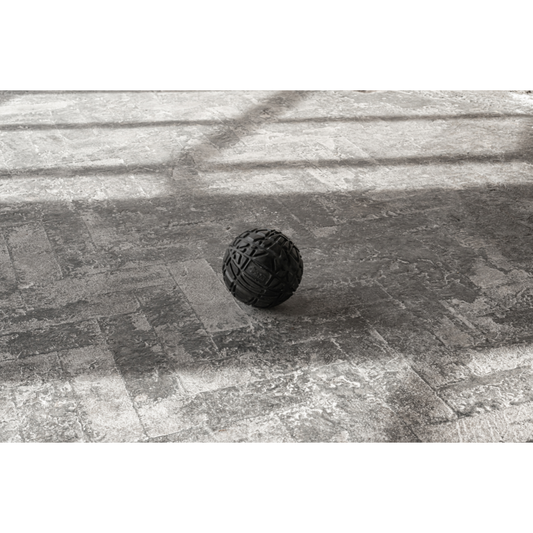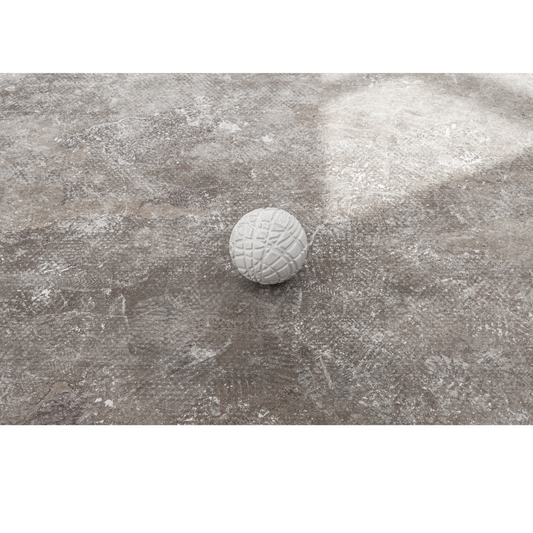Theo Papandreopoulos
Echo's Bones (II)
Lion & Lamb Gallery (March 2023)
Farnham, United Kingdom
PART II
*10-minute study
In Part II/II of this survey of Theo Papandreopoulos's exhibition Echo's Bones, Sunend will further examine Papandreopoulos's key themes through sculpture works made from testosterone powder and assemblage works incorporating military stickers and Nazi uniform trousers. Papandreopoulos's absurd juxtapositions and amplification of specific elements, reveal the tension of deviant eroticism embedded within standardised power structures. The works in this part investigate the role of physical fitness, politics, and religion within military systems and their broader influence on mainstream society, informed by Papandreopoulos's experiences growing up in the Greek Orthodox faith and serving in the Hellenic Army.
Key references and methodology: In Part II of Sunend's survey of Echo's Bones, Papandreopoulos's exploration of masculinity and power is framed through minimalist aural works that evoke the subtle demands of "quiet strength" inherent in middle-class values (Mosse, 1996). Referencing Rousseau’s argument that physical vigour fosters intellectual growth and moral worth (Mosse, 1996), the works also engage with the militaristic ideals of fitness and moral courage, as seen in German Gymnastics. Sunend connects this discourse to the semiotics of military power, where religion and politics historically converge with violence, creating tensions between unequal masculinities (Kovitz, 2003), while reflecting on the fluid and complex nature of male identity, as explored through the works of Beckett and Bacon.
Recap: In Part I of the survey, Sunend looked at how Papandreopoulos deconstructs seemingly banal objects by drawing on his experiences in Greece's compulsory national military service. It focused on his works Dragon Skin and Untitled wall pieces incorporating a military epaulette form and introduced his curatorial distinction between ‘main’ and ‘supporting’ works through the installation piece dispersed throughout the gallery.
Military fitness and boredom

Untitled, 2019, installation – 12 cm diameter, plaster spheres, testosterone powder, £650
The understated aural minimalism of each work, coupled with the ambience cultivated within the curated space, implicitly communicates a crucial element frequently disregarded in the discourse surrounding masculinity and power: the adherence of “middle class sensibilities […] demand[ing] a ‘quiet strength’” which exudes “virtues such as fair play, harmony, and order” (Mosse, 1996).

Detail of Untitled, 2019, installation, 12 cm diameter, plaster spheres, testosterone powder, £650
In 2019, Papandreopoulos began a research project investigating the performative aspects of online bodybuilding culture. Two of the resultant works, both Untitled and incorporated within the Echo’s Bones exhibition, materialised through the process of casting actual muscle balls typically used for myofascial release, self-massage, and trigger point therapy to relieve muscle tension, improve flexibility, and treat chronic muscle pain. The sculptures were cast using a 50/50 mixture of plaster and powdered testosterone, embodying the dual processes of destruction and repair involved in muscle growth. As the plaster destroys the original form to create a negative replica, testosterone represents the anabolic process of muscle tissue synthesis. The sculptures' marble-like surface texture highlights the tension between the functional purpose of the original object and its abstract aesthetic form.

Photograph of the Reich School of Physical Education, by Anna Koppitz, sourced from Public Domain
The notion of conquering arduous landscapes through the development of physical prowess and rigorous self-discipline leading to the attainment of moral virtue finds historical precedent in the writings of Jean-Jacques Rousseau. Specifically, within his treatise Emile (1762), Rousseau posits a direct correlation between physical vigour and intellectual development, stating: "Once make him in vigour, and he will soon become a man in understanding," equating "manly beauty" with "moral worth" (Mosse, 1996). This line of thinking persisted with the advent of German Gymnastics, a movement that emphasises the notion that "a fit and beautiful body indicates a noble soul," and that "physical strength denotes moral courage" (ibid).

Untitled, 2019, installation, 12 cm diameter, plaster spheres, testosterone powder, £650
Within the exhibition space, the isolated, spherical sculptures, strategically positioned on the floor, also illuminate the frequently disregarded phenomenon of boredom experienced within the regimented environment of military life. The sculptures function as subtle cues referencing the domesticated state of tedium encountered by soldiers during extended periods of non-engagement in between or during missions. These objects, akin to a cat's fascination with a ball, serve as a form of escapism, momentarily alleviating the harsh realities of military existence. The juxtaposition of the muscularity of the balls with the fragility of the sculptures generates a contrast, underscoring the tension between the demands of warfare and the yearning for normalcy. In contrast with the exhibition's prevailing ominous undercurrent, these works introduce an unanticipated sense of play.

Untitled, 2019, installation, 12 cm diameter, plaster spheres, testosterone powder, £650
In continuity with the strictly defined, top-down structure of the military, the curatorial framework of the exhibition itself aligns with a classification system established by Papandreopoulos. This system categorises works as either ‘supporting’ or ‘main.’ While ‘supporting’ works retain their autonomy as independent pieces, they function metaphorically as pillars, providing structural support for the ‘main’ works. Within this framework, the creatine and military rank stars displayed on the floor are concieved as a supporting work, whereas the Untitled muscle balls, Untitled epaulettes (Part I), and Dragon Skin (Part I) are designated are main works.
God and Country
With dagger and grenade / Col pugnale e con la bomba
Living with terror / Nella vita del terrore
When the shell explodes / Quando l’obice rimbomba
Our hearts are steadfast / Non ci trema in petto il cuore
Our one true flag / Nostra unica bandiera
Has one colour only / Sei di un unica colore
A flame that is all black / Che divampa in ogni cuor
Blazing in every heart! / Che divampa in ogni cuor!
- A. V. Savano and M. L. Straniero, Catti dell’Italia fascista (Rome, 1979)

Untitled, 2023, 3D printed boot sole 24 x 22 cm atop folded WWII military trousers
A ‘supporting’ assemblage work features a grey, 3D-printed boot sole, crafted in an exaggerated, oversized form. This outsized form rests incongruously upon a pair of authentic World War II Nazi uniform trousers. Papandreopoulos deliberately replicates a commonplace scene – the neatly folded uniform with boots placed atop – a visual trope observed across various militaries and prison settings, and factories around the world. Through this seemingly banal replication, Papandreopoulos draws a subtle parallel between the emphasis on order and uniformity within these institutions and the corresponding constriction of individual identity. The weight of the impossibly large boot suggests the force of external and personal expectations to conform to a uniform, monolithic identity within such rigidly structured environments. The Nazi uniform trousers underpin the authoritarian nature of this force, whereby failing to fit may entail nefarious consequences.
This work, alongside the aforementioned ones employing contrasting elements, engages in a cynical embrace of the military's attachment to its rigid adherence to uniform masculinity (uniformity, strength, etc.). It stands in opposition to an ostensibly feminine individualism, characterised by stylistic expression and a perceived weakness. However, Kovitz (2003) argues that this binary is a deliberate construct, employed to "deflect, mask, and contain these tensions between multiple or unequal military masculinities."

Untitled, 2023, 2 metal ornaments 3 x3 cm (each), 2 stickers 4 x 5 cm (each)
Also ‘supporting’ are two sticker works strategically placed within a window niche of the gallery space. These Untitled works directly confront the alliance between the military and religious institutions. The stickers depict juxtaposed imagery: miniature religious ornaments of saints, commonly carried by Greek soldiers, placed atop military helicopters that almost resemble winged insects. The semiotic power of this juxtaposition lies in its ability to suggest a potentially "unsuggestable fact" (Toibin, 2015): the historical co-dependence between religion and brute military force that led to the violent rise of Christianity in Europe and Islam in West Asia against the more natural indigenous pagan cultures.

Photo of three U.S. Navy chaplains, showing the symbols for Christian, Muslim, and Jewish chaplains. Photo taken with camera belonging to Rabbi Arnold Resnicoff, the Jewish chaplain in the photo, for his collection.
War is ritually complex, …bound up with sacred meaning and practice: rituals were consulted, animals and humans sacrificed, or other religious ceremonials and rites performed to solicit divine guidance, support, or intervention or to ensure auspicious conditions. For example, Menelaus, husband of the abducted Helen of Troy, is reported by Herodotus to have sacrificed two local children while in Egypt in the hopes of accelerating the advent of favourable winds by which to sail.
- Herodotus, 1954

Triumph Of Faith Christian Martyrs In The Time Of Nero by Eugene Romain Thirion Private collection/Photo © Bonhams, London, via Bridgeman Images
This is true of Ancient Assyria, where priests held a pivotal role in interpreting omens and framing military campaigns as divinely sanctioned endeavours (Keshen, 1996). When considering the realities of mandatory conscription, a system reliant on motivations beyond religious framing is needed (Kovitz, 2003). This is where blessing rituals take on a crucial socio-psychological function. By reassuring soldiers of divine backing and reframing their combat as a god-ordained duty, these rituals foster a sense of purpose and moral justification. Soldiers are no longer mere participants in earthly conflicts; they are transformed into instruments of a divine will, a transformation crucial for bolstering morale and ensuring battlefield cohesion. In which case what does the military commander become in relation to God with their higher rank.
 Waiting for Godot, source: Wikipedia.org
Waiting for Godot, source: Wikipedia.org
By establishing the correlation between the thematic underpinnings of the penultimate works by Samuel Beckett and Francis Bacon, a connection can be drawn to Papandreopoulos. This convergence hinges on a shared examination of the multifaceted nature of (male) identity, characterised as "protean, uncertain, unsingular, ready to be doubled or shadowed, poised to move outward into a second self, or another self, or into a figure hovering near, waiting for substance" (Toibin, 2015). However, Papandreopoulos's intervention deviates not only in its utilisation of sculptural elements, but also in its more audacious embrace of the unmentionable aspects of individualistic deviance in a deliberate distancing from the societal.

Detail of the element from which was designed the structure for Untitled, 2023, epaulette works
Theo Papandreopoulos’s exhibition grapples with the inherent tension between the rigidly defined structures of societal organisation, exemplified by military and civilian hierarchies, and the natural human predilection for spontaneous action and individual expression. The survey, titled Echo's Bones, unveils the “contradictions in the context of” the established aesthetic of monumentality (Ades, 1995), a visual language traditionally employed to represent authority, dominance, and established power dynamics. Yet, amidst this provocative conceptual framework, through their implementation of dual perspectives and spatial uncertainties, the works achieve an elegant and poetic form. Papandreopoulos offers us a Beckettian pared down, "intelligible compressed language to deal with the complexity" (Calvocoressi, 2015) of contemporary masculinity.
End of PART II
Notes (Part I and II)
Hobsbawn, E. (1996). Preface. In Art and Power: Europe Under Dictators 1930-45. Hayward Gallery.
Elliot, D. (1996). The Battle for Art. In Art and Power: Europe Under Dictators 1930-45. Hayward Gallery.
Benton, T. (1996). Speaking Without Adjectives. In Art and Power: Europe Under Dictators 1930-45. Hayward Gallery.
Sylvester, D. (2000). Looking Back at Francis Bacon.
Calvocoressi, R. (2015). Francis Bacon: Leaving Out. In Francis Bacon Late Paintings. Gagosian Gallery.
Tóibín, C. (2015). Late Francis Bacon: Spirit and Substance. In Francis Bacon Late Paintings. Gagosian Gallery.
Keshen, J. (1996). Propaganda and Censorship during Canada’s Great War.
Mosse, G.L. (1993). The Image of Man.
Kovitz, M. (2003). The Roots of Military Masculinity. In Military Masculinities. Praeger.
Higate, P.R. (2003). “Soft Clerks” and “Hard Civvies”: Pluralizing Military Masculinities. In Military Masculinities. Praeger.
Woodward, R. (2003). Locating Military Masculinities: Space, Place, and the Formation of Gender Identity and the British Army. In Military Masculinities. Praeger.Beckett, S. (1952). Waiting for Godot.
Beckett, S. (1933). Echo’s Bones.
Rousseau, J.-J. (1762). Emile.
Herodotus. (1954). Histories. Translated by Aubrey de Selincourt. Middlesex: Penguin Books.
Ferril, A. (1985). The Origins of War. London: Thames and Hudson.
Theweleit, K. (1977). Male Fantasies.
Savano, A.V., & Straniero, M.L. (1979). Catti dell’Italia fascista. Rome.
Punin, N.N. (1920). ‘The Monument to the Third Internation’. Translated by Christina Lodder. In Modern Art and Modernism, Supplementary Documents (Blocks VIII-IX).
Bacon, F. (1955). Quote in The New Decade: 22 European Painters and Sculptors. Edited by Andrew Carnduff Ritchie. MoMA.
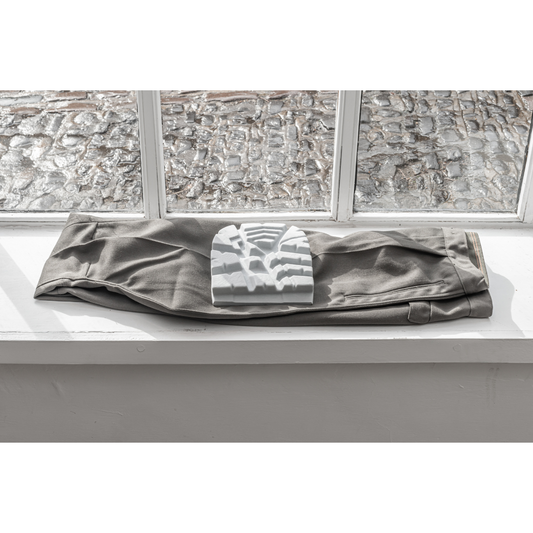
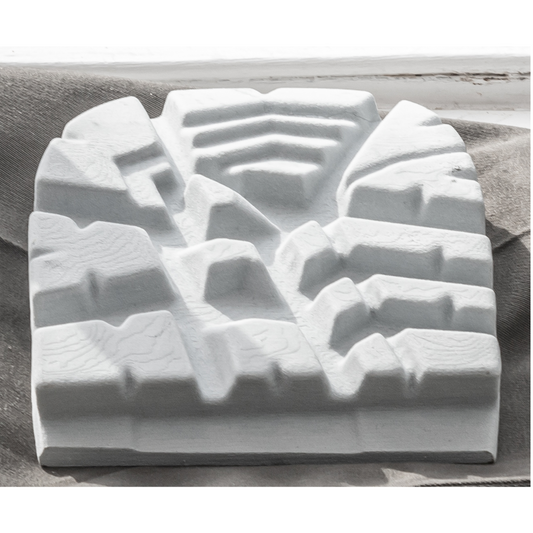 SoldTheo Papandreopoulos
SoldTheo Papandreopoulos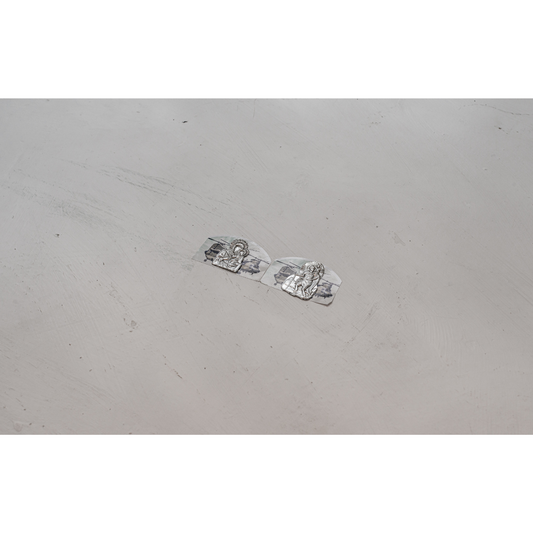
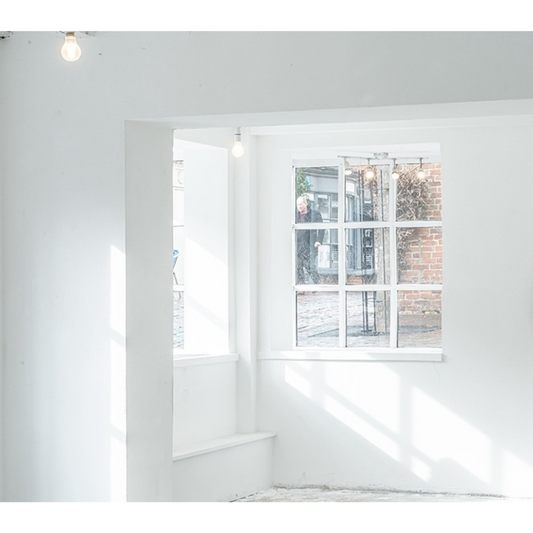 SoldTheo Papandreopoulos
SoldTheo Papandreopoulos












